MM UT 13. The Origins of the Frieze of Life
The Origins of the Frieze of Life. Oslo, 1928?
The Origins of the Frieze of Life. Oslo, 1928?
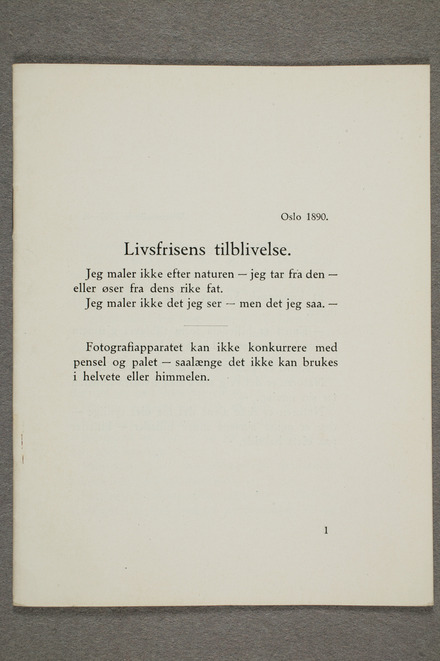
I do not paint what I see – but what I saw. –
The camera cannot compete with
the brush and palette – as long as it cannot be used
in heaven or hell.
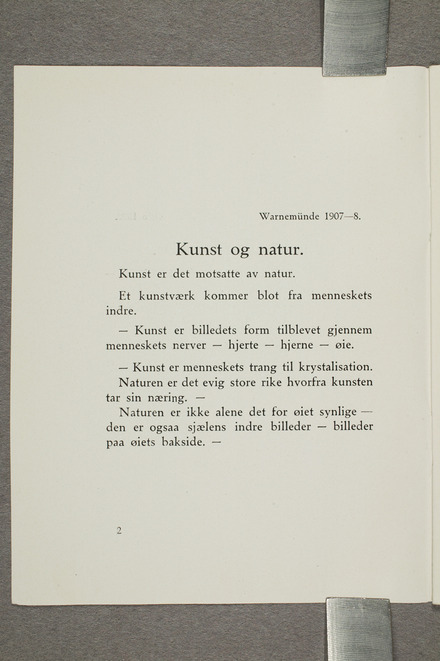
A work of art comes from the inner soul of
a human being.
– Art is the picture’s form materialised through
human nerves – heart – brain – eye.
– Art is the human craving for crystallization.
Nature is the infinite realm from which art
takes its nourishment. –
Nature is not only that which is visible to the eye –
it is also the inner images of the soul – images
on the back side of the eye.
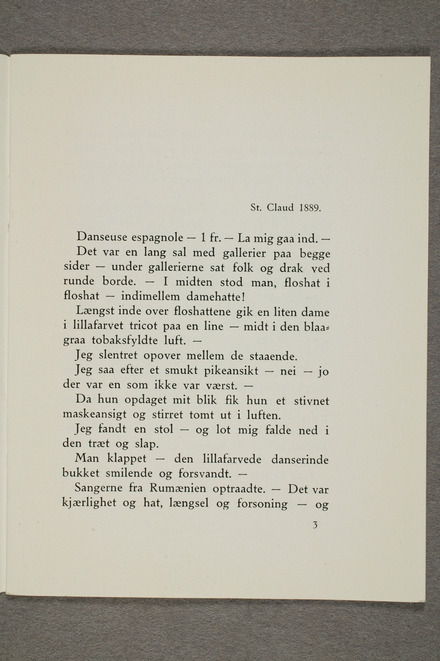
A Spanish dancer – 1 f. – Why not go in. –
There was a long hall with galleries on either
side – under the galleries people sat drinking
at round tables. – One stood in the middle, a forest of
top hats – in between ladies’ hats!
At the far end of the hall above the top hats – in the midst
of the blue-grey tobacco-filled air – a little lady
in a violet-coloured tricot balanced on a tightrope. –
I moved ahead in between the standing crowd.
I was looking for a pretty maiden’s face – no – yes
there was one that was not so bad. –
When she discovered my gaze she adopted a rigid
mask-like expression and starred emptily out into space.
I found a chair – and fell down on it
tired and weak.
The crowd clapped – the violet-coloured dancer bowed
with a smile and then disappeared. –
Then the singers from Romania performed. – It was
about love and hate, longing and reconciliation – and
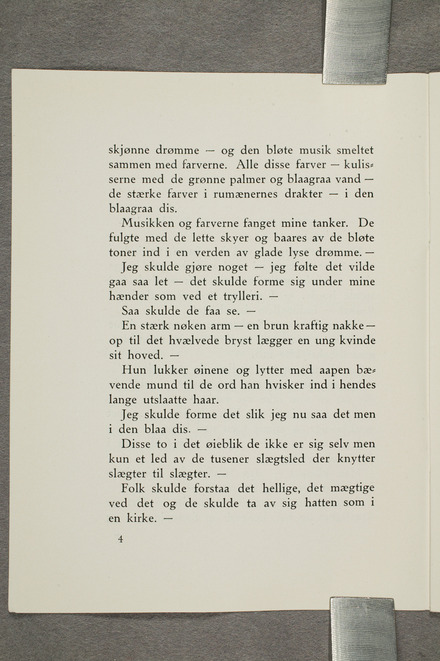
beautiful dreams – and the soft music blended
in with the colours. All these colours – the stage
setting with its green palm trees and blue-grey water –
the vibrant colours in the Romanian costumes – in the
blue-grey haze.
The music and colours captivated my thoughts. They
followed the wispy clouds and were carried by the soft
notes into a world of joyful and luminous dreams. –
I would create something – I felt that it would
come easily – it would take shape in my hands
as though by magic.
Then they would see. –
A strong naked arm – a tanned brawny neck –
and against the bulging chest a young woman leans
her head. –
She closes her eyes and listens with an open quivering
mouth to the words he whispers into her
long flowing hair.
I would create it as I envisioned it now but
in the blue haze. –
These two in the instant they are no longer themselves but
merely a link that throughout millenniums connects
one generation to the next. –
People would understand the sanctity and power
of it and would take off their hats as in
a church. –
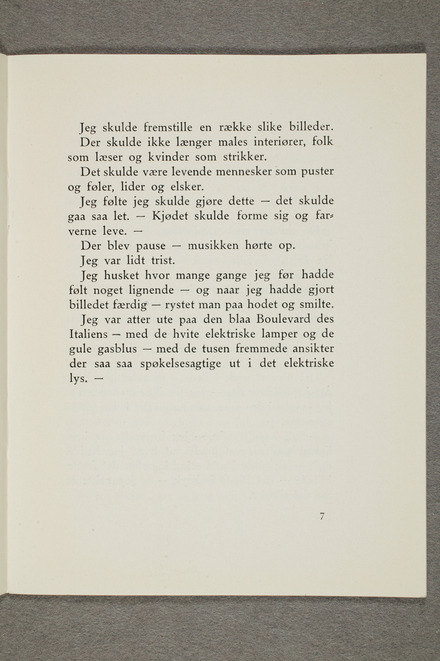
I would create a number of such pictures.
One shall no longer paint interiors, people
reading and women knitting.
They will be people who are alive, who breathe
and feel, suffer and love.
I felt that I would create this – it would
come so easily. – The flesh would take form and
the colours come to life. –
There was a pause – the music stopped.
I was a little sad.
I remembered how many times I had previously
felt something similar – and when the picture
was finished – one shook one’s head and smiled.
I was once again out on the blue Boulevard des
Italiens – with the white electric lamps and the
yellow gas lights – with the myriad unfamiliar faces
that appeared so ghostly in the electric
light. –
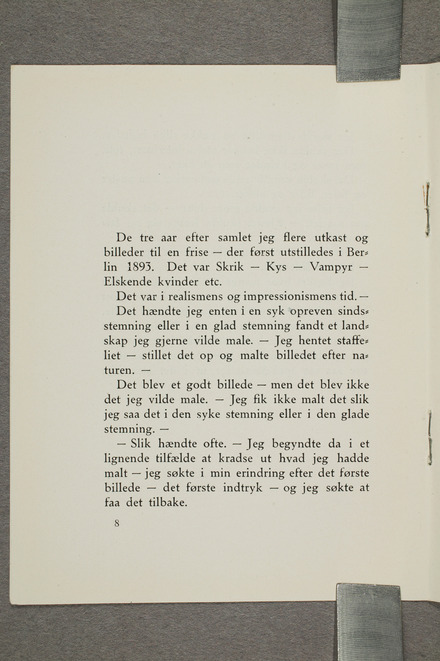
The following three years I collected several drafts and
pictures for a frieze – that was exhibited for the first time in Berlin
in 1893. There was Scream – Kiss – Vampire –
Women making love etc.
It was during the time of Realism and Impressionism. –
It happened that I discovered a landscape that I wanted to paint
while either in a sickly disturbed state of mind or in a
joyful mood. – I fetched my easel
– set it up and painted the picture
from nature. –
It was a good picture – but it was not
what I had wanted to paint. – I did not succeed in painting it
as I had seen it during the sick state or during the joyful
mood. –
– This occurred often. –I then began in a
similar situation to scrape away what I had
painted – I searched in my memory for the first
image – the first impression – and I attempted to
retrieve it.
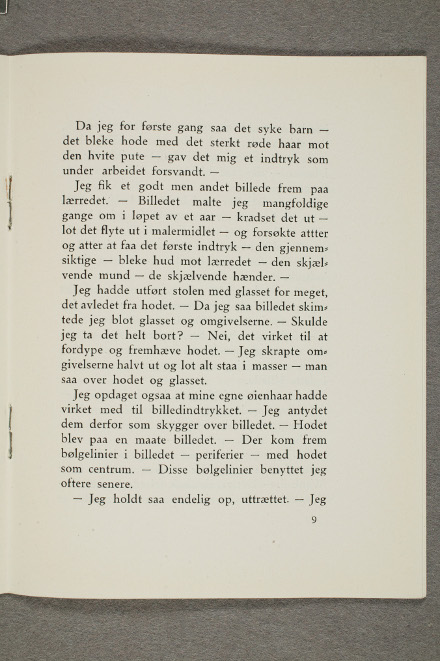
When I saw the sick child for the first time –
the pale head with the vibrant red hair against
the white cushion – it made an impression that
disappeared as I worked on it. –
I achieved a good yet different picture on
the canvas. – I painted the picture numerous
times in the course of a year – scraped it –
dissolved it in generous applications of paint – and endeavoured again
and again to attain the first impression – the
translucent – pale complexion against the canvas – the quivering
mouth – the quivering hands. –
I had overdone the chair and the glass,
it distracted [attention] from the head. – When I looked at the picture
I could only just make out the glass and the surroundings. – Should
I remove it completely? – No, it contributed to deepen
and accentuate the head. – I scraped away the surroundings
halfway and allowed them to remain as masses, which one
could see above the head and glass.
I discovered furthermore that my own eyelashes had
contributed to the visual expression. – I therefore
included a hint of them as shadows on the surface of the picture. – The head
became the picture in a way. – Wavy lines appeared
in the picture – in the peripheries – with the head
as the central element. – I often made use of these wavy
lines later.
– I finally ceased, exhausted. – I
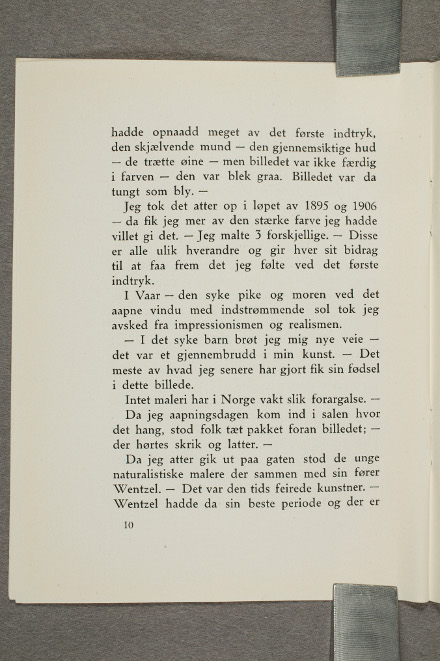
had achieved a great deal of the first impression,
the quivering mouth – the translucent complexion
– the weary eyes – yet the colour of the picture
was not complete – it was pale grey. The picture had become
heavy as lead. –
I took it up again in the course of 1895 and 1906
– at which time I achieved more of the vibrant palette that I had
wished to give it. – I painted 3 different [versions]. – These
are all different from one another and each contributes something
to elicit what I felt during the first
impression.
With Spring – the sick girl and the mother by the
open window with the sun pouring in I said farewell
to Impressionism and Realism.
– In the sick child I paved new roads for myself –
it was a breakthrough in my art. – Most
of what I have done since had its genesis
in this picture.
No painting in Norway has elicited such a scandal. –
When I entered the hall where it hung on
opening day, people stood crowded together in front of the picture; –
shouts and laughter could be heard. –
When I went out into the street again the young
naturalist painters stood together with their leader
Wentzel ![]() . – He was the celebrated artist of that time. –
. – He was the celebrated artist of that time. –
Wentzel was at the height of his career and there are
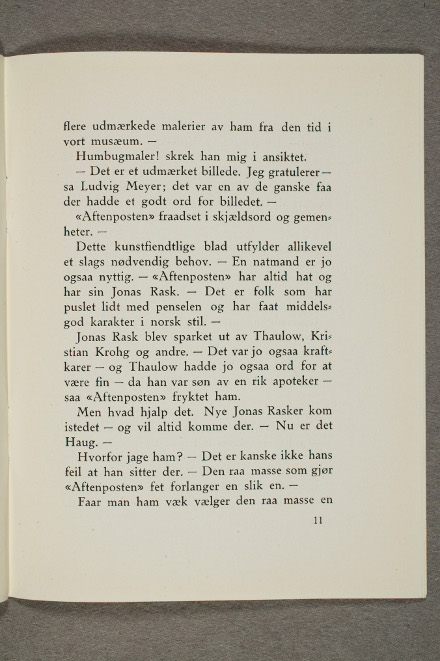
several excellent paintings by him from that time
in our museums. –
Humbug painter! He cried to my face.
– It is an excellent picture. My congratulations –
said Ludvig Meyer ![]() ; he was one of very few
; he was one of very few
who had a good word to say about the picture. –
“Aftenposten ![]() ” revelled in abusive and vile
” revelled in abusive and vile
invectives. –
This paper, which is hostile to art, nevertheless fills
a kind of basic need. – A Nightman is also
useful to be sure. – “Aftenposten” has always and
still has its Jonas Rask ![]() . – There are those who have
. – There are those who have
fiddled a little with a brush and who have obtained passing
grades in Norwegian composition. –
Jonas Rask was kicked out by Thaulow ![]() ,
,
Kristian Krohg ![]() and others. – These were powerful
and others. – These were powerful
men mind you – Thaulow even had a reputation for being
distinguished – as he was the son of a wealthy pharmacist –
so “Aftenposten” feared him.
But what good did that do. New Jonas Rasks appeared
in his place – and will forever appear there. – At present it is
Haug ![]() . –
. –
Why chase him away? – It may not be his
fault that he sits there. – The vulgar masses that fatten
“Aftenposten” demand someone like him. –
If one gets rid of him the vulgar masses will choose
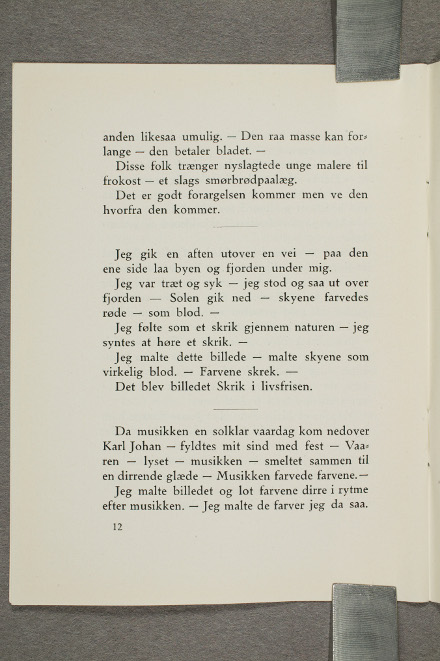
another equally intolerable substitute. – The vulgar masses
can make their demands – they pay for the paper. –
These people require freshly slaughtered young artists for
breakfast – a kind of sandwich meat.
It is a good thing that there is scandal but beware
from whence it comes.
I walked along a road one evening – on one
side the city and the fjord lay beneath me.
I was weary and sick – I stood looking out over
the fjord – The Sun was setting – the clouds turned
the colour red – like blood. –
I felt as though a scream passed through nature – I
thought I heard a scream. –
I painted this picture – painted the clouds like
real blood. – the colours screamed. –
It became the picture Scream in the Frieze of Life.
When the music could be heard approaching down
Karl Johan ![]() one sunny day – my spirits were filled with exaltation –
one sunny day – my spirits were filled with exaltation –
Spring – the light – the music – merged together into
quivering joy – The Music coloured the colours. –
I painted the picture and made the colours quiver with the rhythm
of the music. – I painted the colours I saw then.
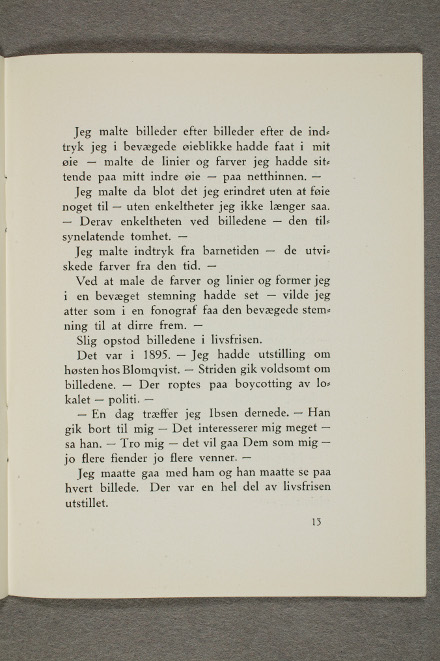
I painted picture upon picture in keeping with the impression
made on my eye in a moment of heightened
emotion – painted the lines and colours that remained
fastened to my inner eye – to the retina. –
I painted only what I remembered without adding
anything to it – without the details that I no longer saw.
– Hence the simplicity of the pictures – the
apparent emptiness. –
I painted impressions from childhood – the faded
colours from that time. –
By painting the colours and lines and shapes I
had seen in an emotional state – I wished
to recapture the quivering quality of the emotional
atmosphere like a phonograph. –
This is how the pictures of the Frieze of Life came into being.
It was in 1895. – I had an exhibition in
the fall at Blomqvist ![]() . – There was a heated controversy about
. – There was a heated controversy about
the pictures – There were calls for boycotting the
venue – the police [were summoned]. –
– One day I met Ibsen ![]() down there. – He
down there. – He
came over to me – It interests me greatly –
he said. – Believe me – You will experience the same fate as I –
the more enemies [you attract] the more friends. –
I had to accompany him and he insisted on seeing
every picture. A great portion of the Frieze of Life
was displayed.
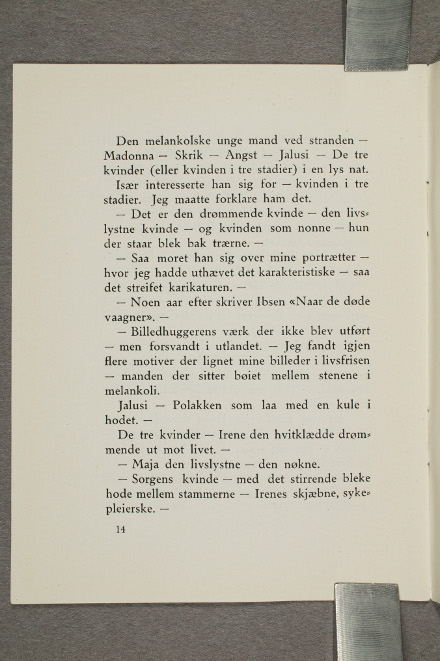
The melancholic young man by the shore –
Madonna – Scream – Angst – Jealousy – The Three
Women (or Woman in Three Stages) on an illuminated night.
He was particularly interested in – Woman in Three
Stages. I had to explain it to him.
– It is the dreaming woman – woman with a lust
for life – and woman as nun – the pale one
standing behind the trees. –
– Then he was amused by my portraits –
how I had emphasised a certain characteristic – so that
it bordered on caricature. –
– Some years later Ibsen ![]() wrote “When We Dead
wrote “When We Dead
Awaken ![]() ”. –
”. –
– The Sculptor’s work that was never executed –
but disappeared abroad. – I recognised several
motifs that resembled my pictures in the Frieze of Life
– the man sitting slumped over amidst the boulders
in Melancholy.
Jealousy – the Polish man who lay with a bullet
in his head. –
The Three Women – The idealistic Irene ![]() dressed in white
dressed in white
about to step out into life. –
– Maja ![]() the one with a lust for life – the naked one.
the one with a lust for life – the naked one.
– The grieving woman – with the staring pale
head in between the tree trunks – Irene’s fate,
a nurse. –
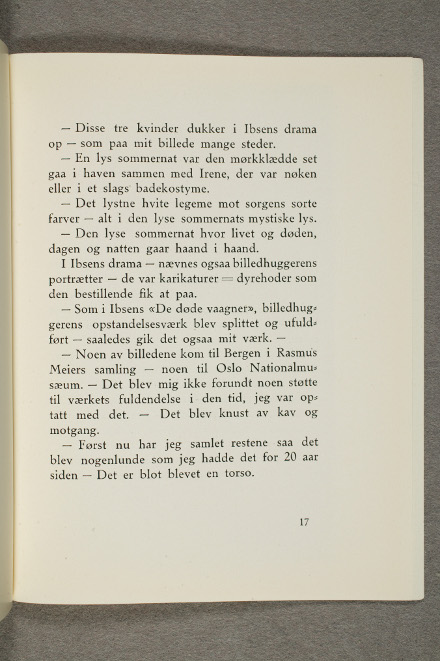
– These three women appear many times in Ibsen ![]() ’s
’s
drama – as in my picture.
– An illuminated summer night the woman in black was seen
walking in the garden with Irene ![]() , who was naked
, who was naked
or wearing a kind of bathing costume.
– The sensual white body against the black colours
of grief – all in the mystical light of the illuminated summer night.
– The illuminated summer night when life and death,
day and night walk hand in hand.
In Ibsen’s drama – the sculptor’s portraits
are also mentioned – they were caricatures = animal heads
which the models received as a bonus. –
– As in Ibsen’s “When We Dead Awaken ![]() ”, the sculptor’s
”, the sculptor’s
work depicting the Resurrection was split up and never
completed – that is how it ended with my work as well. –
– Some of the pictures ended up in Bergen ![]() in Rasmus
in Rasmus
Meyer’s collection ![]() – some in the National Museum
– some in the National Museum ![]()
in Oslo. – I was not granted any support
to complete the work at the time I was preoccupied
with it. – It was crushed by turmoil and
adversity.
– It is only now that I have collected the remains so that
it has become approximately as it was 20 years
ago – It had merely become a torso.
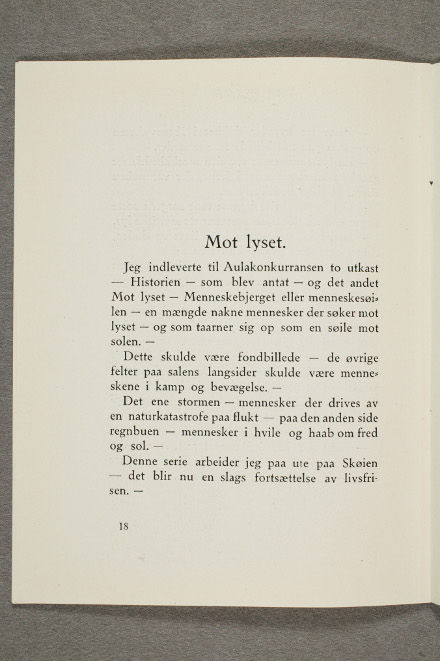
This was intended for the rear wall – the remaining panels
along the lateral walls of the hall would be human
beings struggling and in motion. –
One of them The Storm – humans who are driven into
flight by a natural catastrophe – on the other side
a rainbow – humans in repose and hopeful for sunshine
and peace. –
I am working on this series out at Skøyen ![]()
– it will be a sort of continuation of the Frieze of
Life. –